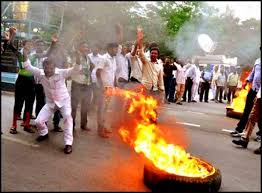
HRD Minister M M Pallam Raju, Tourism Minister K Chiranjeevi, Minister of State for Commerce D Purandeswari and Minister of State for Railways Surya Prakash Reddy, all Congress leaders, met Singh together to press for acceptance of their resignations. They decided not to attend office.
Singh told them that he will look into their request.
"Pallam Raju has given his resignation today but Chiranjeevi and Surya Prakash Reddy gave resignation two days ago. So, today, we have requested the Prime Minister to expedite it and accept our resignations," Purandeswari, flanked by other three colleagues, told reporters.
Explaining reasons for their decision to quit the government, she said, "we need to go back to the people and tell the people how we want to solve (the issue). People are not wiling to listen to us unless we tender our resignation and go back as one of them. So as long as we continue as Ministers they are not going to listen to us."
She said they presented the entire situation to the Prime Minister and requested him to accept their resignations.
"We expressed our inability to continue in the Council of Ministers. We in detail gave him the clear picture of the ground situation in Andhra," Purandeswari added.
"We also told him (Singh) that people of Andhra Pradesh did expect the Antony committee to come to the state of Andhra Pradesh but since thw Committee has not come, now people are losing confidence that the justice will be done to them," she said.
They were accompanied by two other Ministers from the region -- K S Rao (Textiles) and Killi Kripa Rani (MoS IT and Communications) but it was not clear whether they also pressed for their resignations. Rao and Rani did not appear before the media.





Comments
Add new comment